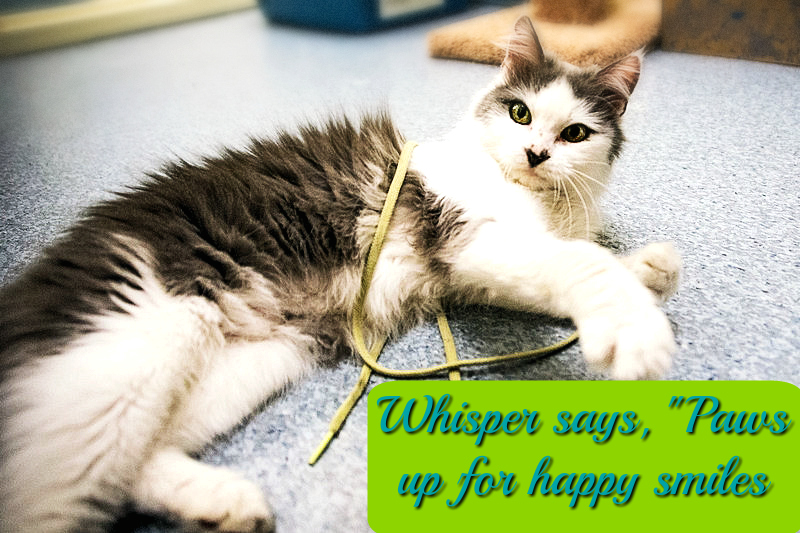
From Homeless Shelter Cat to Happy Vet Clinic Cat: Whisper’s Story
From Homeless Shelter Cat to Happy Vet Clinic Cat: Whisper’s Story
We’re excited to share to a guest post by Dr.Brenda Eisenhauer DVM, a veterinarian based in Colorado. Her cat Whisper, is a working cat who survived a rough start and today advocates for feline dental health. It’s not because of her good teeth. In fact, she doesn’t have any. All of her teeth needed to be extracted, and she’s lucky to be free of a painless condition many cats silently suffer from, feline resorption lesions.
There is more to Whisper’s story. Meet Dr. Brenda and Whisper.
Dr. Brenda reveals the dilemma all vets face: what happens when a special animal captures their heart. They can’t adopt them all. In this case, it’s a second chance and unexpected life purpose.

I get the opportunity to meet a lot of cats! As both a private practice and shelter veterinarian I meet and treat hundreds and hundreds of cats a year. Through the years, I’ve been able to see the wide range of feline personalities and the quirks that make each cat unique.
I’ve also learned that when there is one cat, out of the thousands, that really stands out to me there is little chance that I can resist taking them home. Sometimes, I tell myself it’s just to foster them for a bit and get them out of the shelter. At least, that was the case with Whisper.
Let me introduce you Whisper at work. She takes her job seriously and those big green eyes don’t miss a thing.
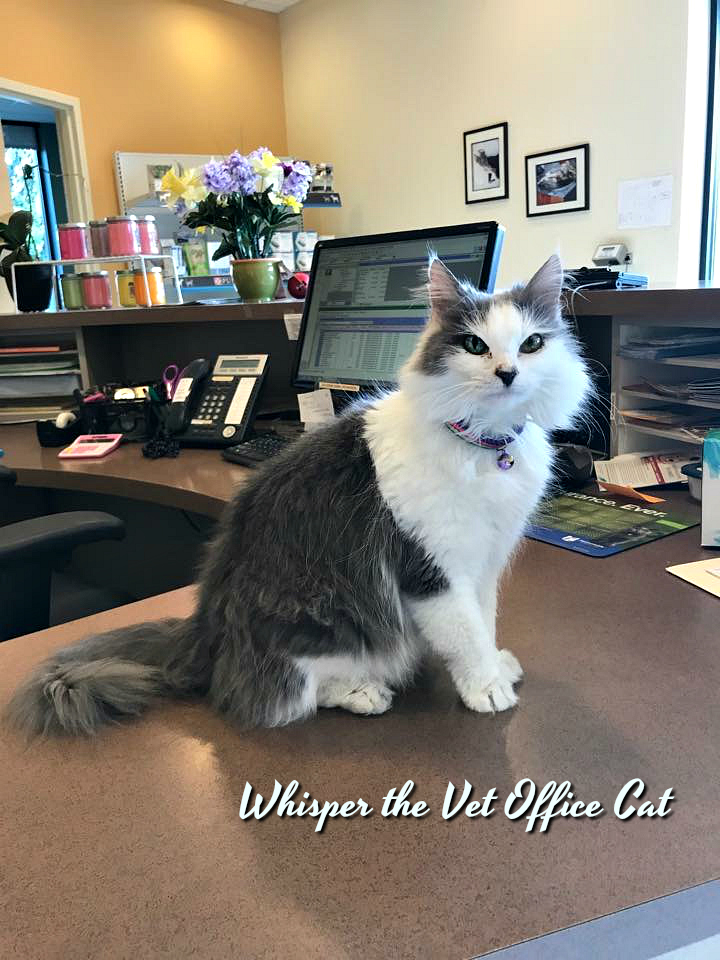
While I first met Whisper at the shelter, she is now a clinic cat at my animal hospital, Parkside Animal Health Center in Aurora, Colorado, where she handles a wide range of jobs. Not the least of which is acting as the official greeter to new clients and their pets. Whisper is 100% certain that every creature that walks through our doors is her friend. Whether that’s a 145lb mastiff, a litter of new kittens or a tortoise, Whisper knows that they can’t wait to meet her! And most of the time she is also 100% correct.
I like to think Whisper is living the good life at our clinic. She has her own room complete with shelves to climb, comfortable beds and a variety of toys that she cycles through. Her soccer skills are getting really good! Whisper is very popular with our clients and I think some clients may be coming in just to see her!
Whisper also handles the important animal to animal consultations while wearing a very stylish bandana:
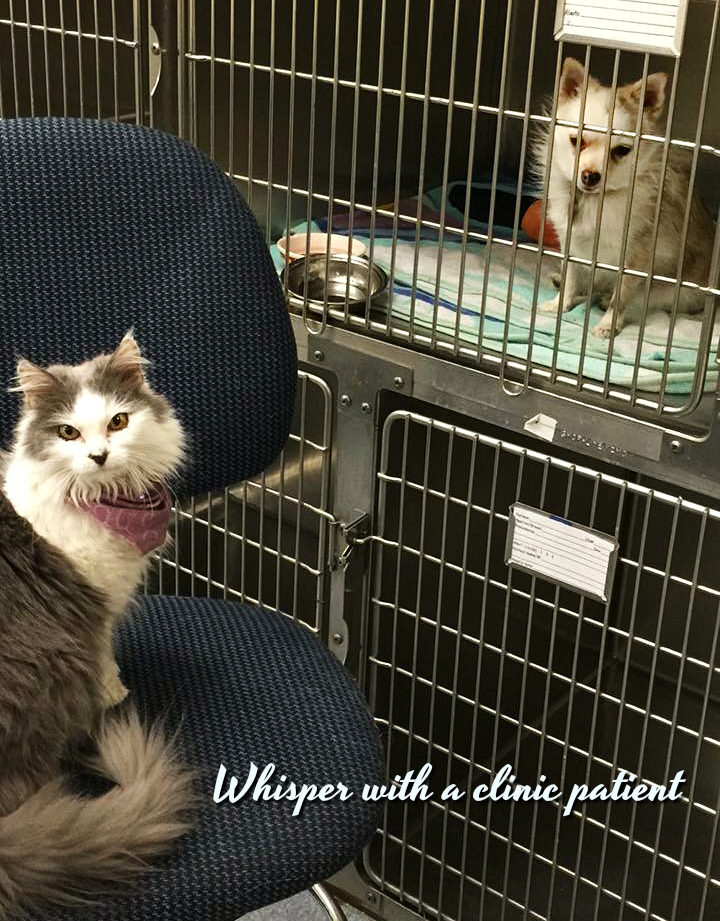
I like to believe that when a pet visits our clinic and sees Whisper living the good life it sets them a little at ease. The veterinary clinic can’t be so bad if there’s a cat with a bandana running the place, right?
But Whisper didn’t always live the high life.
When I first met Whisper at a shelter in Denver she was in rough shape. She came in with several other cats and had likely never received any veterinary care before. She had ear infections in both ears, corneal scarring (likely a result of past trauma), she was underweight and worst of all she had severe dental disease in her remaining teeth.
Whisper’s dental disease diagnosis is common. In fact, according to a report from Banfield, the diagnosis of dental disease beat out the diagnosis of “healthy pet”. That means there are more cats and dogs with dental disease than there are pets without, according to Banfield’s data!
Whisper’s dental disease had plenty of time to progress over the years. Just like in humans, dental disease starts with plaque then progresses to calculus. Calculus is a form of hardened plaque that is much harder to remove. Calculus also provides a rougher and tougher surface that is also ideal for further plaque and bacteria growth.
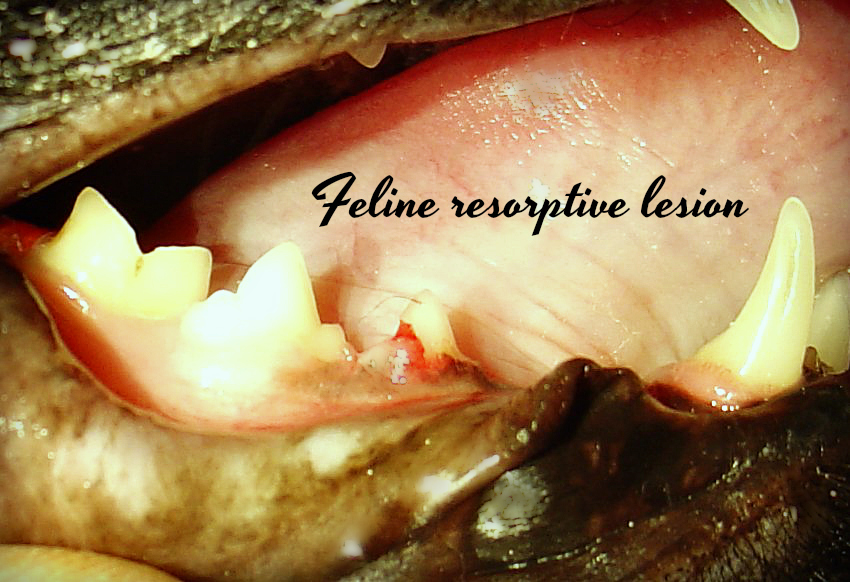
However, the real trouble starts when bacteria gets below the gumline. Bacteria can infect and damage soft tissues and bone in the mouth which eventually leads to teeth falling out. In some severe cases, the bone erodes and the actual shape of jaw can change as a result. As you can imagine, the whole process is quite painful. Even that is really only scraping the surface of how dental disease affects a cat- an infected mouth can impact a cat’s behavior and organ function as well.
Unfortunately, Whisper went through this complete cycle of dental disease and feline odontoclastic resorptive lesions (FORLs) several times over as she slowly lost tooth after tooth. But the problem doesn’t actually end there! Even after teeth have fallen out, they can leave behind partial roots. Roots are just what they sound like- they’re the part of the tooth that keeps everything rooted in the jawbone. These roots, if left behind, can cause a whole host of problems including more infections and a lot more pain.
Dental radiographs revealed that Whisper had retained roots in all four quadrants of her mouth. Not only did she have to have her remaining teeth extracted, Whisper had to have these roots removed from each part of her mouth! Ouch!
But even after Whisper’s dental extractions were complete, her troubles were not over! Whisper, like many cats, stopped eating after her dental surgery. Obviously not eating doesn’t help the healing process and if left unchecked can quickly become life-threatening.
I took Whisper home as a foster after completing her dental hoping that a less stressful environment would get her eating. The traditional approach is to offer cats every kind of stinky wet food there is. Nothing was too rich since the most important part was to get Whisper eating again. We offered Whisper all of the good stuff- what felt like every wet food on the market along with big portions of tuna and other feline delicacies. But Whisper would have none of it! At a loss, we decided to offer Whisper a bowl of dry food. With her usual style, Whisper casually walked over to the bowl and began eating as if to say “Teeth or no teeth I’ll eat what I want.
Whisper is healthy now and doesn’t have to deal with dental pain anymore. While this story has a happy ending and Whisper is now our Chief Dog Bed Tester she didn’t need to go through all those years of pain and discomfort.
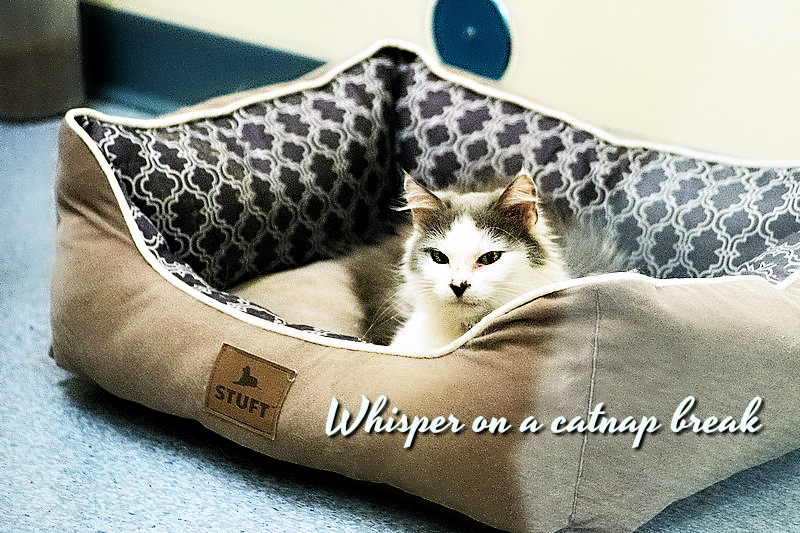
The most important thing to keep in mind with dental disease: while it is the most common veterinary concern in cats and dogs it is also very manageable with regular exams. While dental cleanings can keep teeth healthy and decrease the risk of extraction, 20-60% of cats will still develop feline oral resorptive lesions (abbreviated FORLs) which will require removal. The exact cause of resorptive lesions is unknown, but the process causes the structure of a previously healthy tooth to erode over time. Resorptive lesions are painful and almost always require extraction. While frustrating to veterinarians and owners alike, resorptive lesions only increase the need for regular dental examinations.
Cats are masters at hiding pain and illness.
It is important to remember that our cats can be suffering from severe dental pain but show very few outward signs until the damage is catastrophic. Whisper is no different. Even while suffering from what had to be immense pain, she was still friendly, outgoing and was still eating dry kibble at the shelter. Most owners mistakenly interpret these things as indicators that their cat is happy and healthy. However, it requires regular dental examinations and radiographs to diagnose and treat painful conditions that are hiding below the gumline.
If Whisper had been outside the care of the amazing shelter, her veterinary bill would have been extensive. There’s no doubt about that. Had her previous owner provided a few smaller dental procedures spread out over Whisper’s 10 years, it would have likely cost less than one major “everything must go” procedure. Waiting too long is costly in more ways than one’s wallet.
Whisper is now our greatest advocate for feline dental care and if her story helps just one cat avoid the years of dental pain that she went through then we’re positive that she would consider that a job well done.
Brenda Eisenhauer, DVM is a small animal veterinarian with 20 years of experience in shelter and private practice veterinary medicine as both a veterinary technician and a veterinarian. Brenda currently practices in Aurora, Colorado where she is the owner and veterinarian. Additionally, Brenda works with Denver shelter, The Dumb Friends League, where she has helped care for tens of thousands of homeless pets over the years.
Editor’s note: The holiday season is a busy time of celebrations with hopefully no veterinary emergencies. January is an excellent time to schedule a vet wellness visit before February National Pet Dental Month
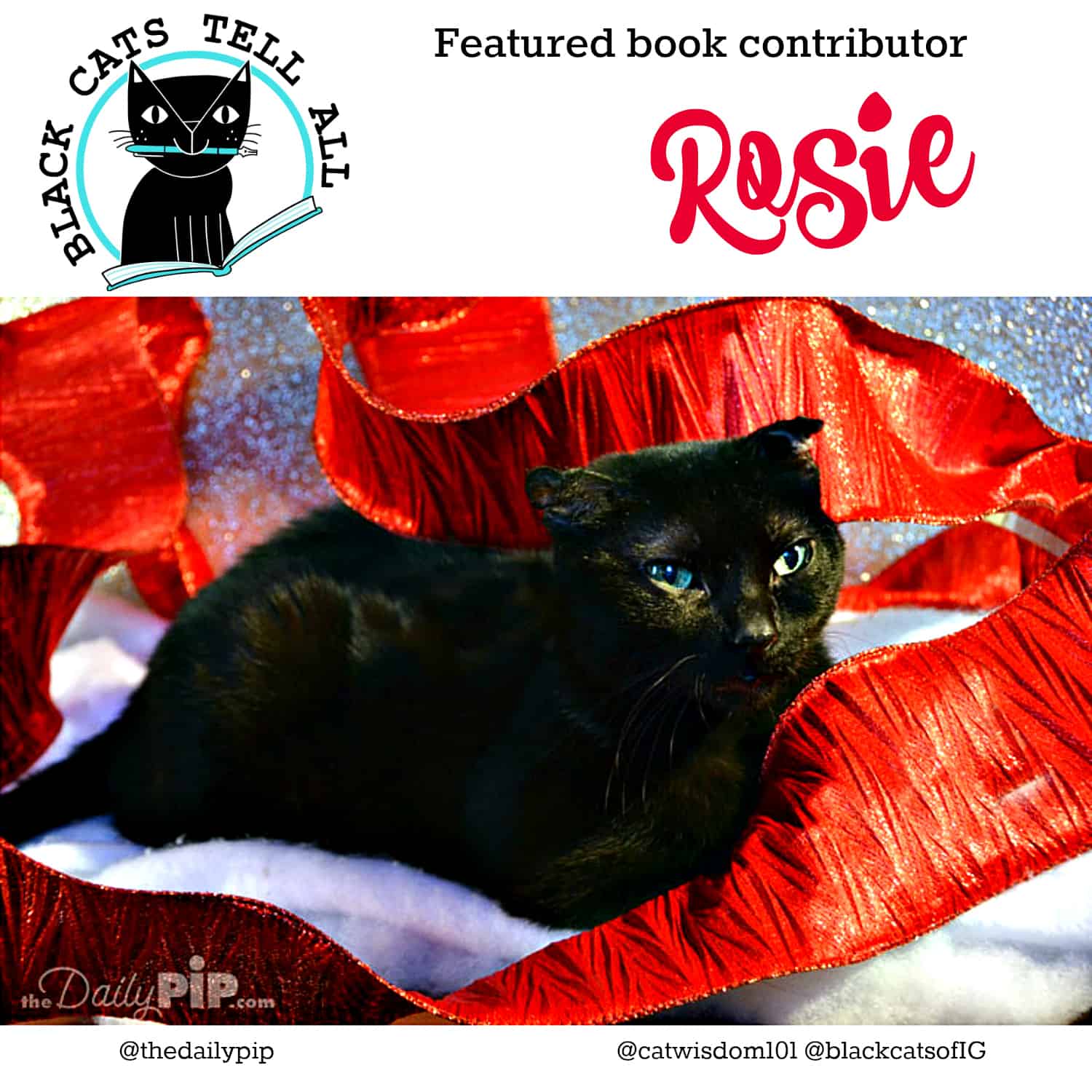



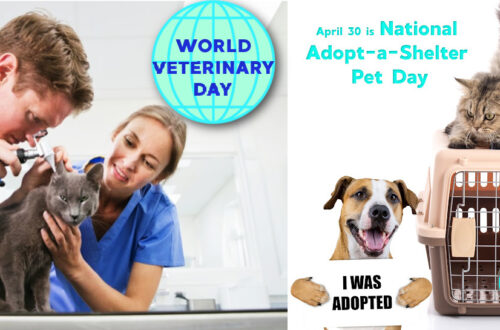
25 Comments
Casey Bradford
“..acting as the official greeter..” Lol, this is funny and cute. But i think, not just official greeter, by looking at her face, all i can say that or interpret, she is the boss. “Look at me.. i’m your boss now!” Okay, i’m just kidding. By the way, thanks for sharing the dental problem issues and i learnt something important today, which is, cats are the masters of hiding pain. Maybe that is a reason people said cats have 9 life.
Felines are superior
Where I live, all the shelters are full, and the vets want to get paid even if it’s a feral cat. There are millions feral cats around, some sick or wounded, and I don’t have the money to take care of all of them.
However, I did find a five weeks old sick kitten with feline herpes, took her to the vet and then home to live with me. Had to put drops in her eyes, which was no easy task. Today she’s a grown fat, healthy cat.
Two other feral cats smelled the cats’ food I put out for my cat, Hazelnut, and jumped in the window of my first floor, ground level apartment. They got to stay too, and they got fat. Princessa and Amiga.
It’s very important to care for feral cats, and there should be more help from the authorities, like more shelters and volunteers. It’s great what you’re doing for these cats. You’re saving them. So many people just don’t care. Almost no one feeds feral cats, and when I fed them, the neighbors gave me hell.
Maria Appleby
Oh Whisper, you beautiful girl! Bless you, and Dr. Brenda.
Layla Morgan Wilde
Thanks for stopping by, Maria 🙂
Skeeter & Izzy
We are sooooooo glad that Whisper got the help and care that she needed! She is such a beauty and I have no doubt about her “job” skills!!! I think that clinic greeters not only help lessen the stress on the incoming animals but on the peeps as well!
Great job Whisper and DR.Eisenhauer!
Luvs
Skeeter and Izzy and the Feral Gang + Twig & Peanut & Romeo & the Angels >^..^^..^<~
Layla Morgan Wilde
Agreed about clinic greeters and stress reduction xo
Ellen Pilch
Such a beautiful kitty. My Angel Snowball lost all her teeth to resorption.
Layla Morgan Wilde
It happens so often and I know you work hard caring for your kitty crew. xo
The Island Cats
Whisper was very lucky to have found such a great vet…and a great home!
ps…the button worked!
Layla Morgan Wilde
Thanks and since I did a WP update the buttons will work from now on xo
ellen
I can see your post!!!!
Cats are indeed masters of hiding pain. Ours get check ups but like the stats prove have had extractions. Usually it has happened when they are older.
hisper is a lovely gal and a a good ambassador!
Layla Morgan Wilde
Yay, all the fixes worked! It’s true older cats are impacted but I’ve see cats as young as a year old with early gingivitis.
Bil
Because of dental problems a couple years ago, at age five my cat Grey Vee was able to keep her canines, but her lower incisors had to be removed. She never slowed down eating and is active as can be today.
Thanks for sharing Whisper’s story.
Layla Morgan Wilde
Grey Vee (great name!) is lucky to have a positive outcome.
Layla Morgan Wilde
Thanks for sharing your experience from France. It’s good to know there are clinic kitties there. Purrs for your holiday card which just arrived. Joyeux Noël mes amies.
Kathryn
Yes, this worked! On my iPhone and on my computer. This is on my computer. I <3 Whisper, and yes, I agree that other animals at the vet will feel more comfortable just seeing Whisper being happy and relaxed. Dental disease is so very sneaky…
Layla Morgan Wilde
Yay, we had some fixes. Dental disease is sneaky and gradual. Our pets can’t speak up and say my upper left molar is hurting. They depend on us to get a diagnosis which is only by a vet.
Layla Morgan Wilde
Yay, and thanks for the update. xo
caren gittleman
Thank you for sharing Whisper’s story with us! Thank COD she found a Veterinarian that not only took care of her dental problem (and other issues) but that LOVES her and gave her a home! Love her wearing her bandana at one-on-one animal consultations!
Layla Morgan Wilde
Whisper was very lucky to have a second chance especially as a senior gal.
Pipo/Angel-Minko/MrJackFreckles
Yah! I read the whole thing! Now I hope my comment goes through!
What a sad story with a good happy ending. She sure is a beautiful kitty!
Our vet has several clinic kitties:)
Layla Morgan Wilde
It went through purrfectly. That’s great to hear about your vet clinic.
Edie Chase
I’m glad Whisper was able to get the help she needed. I shared this story.
Layla Morgan Wilde
Thanks Edie and for sharing.
easyweimaraner
I’m so glad for Whisper… and I love that so much vet clinics have a clinic cat… we have one too and it is the bestest companion when you sit and wait with the heart full of sorrows… some comforting purrs can do miracles…